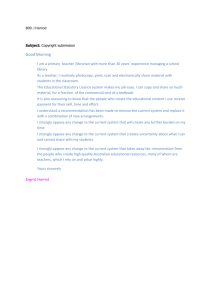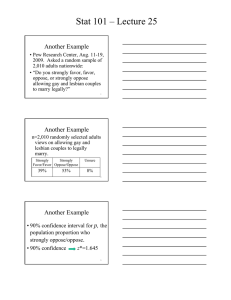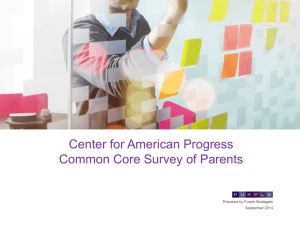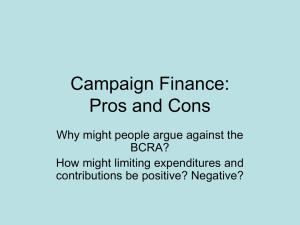R
advertisement
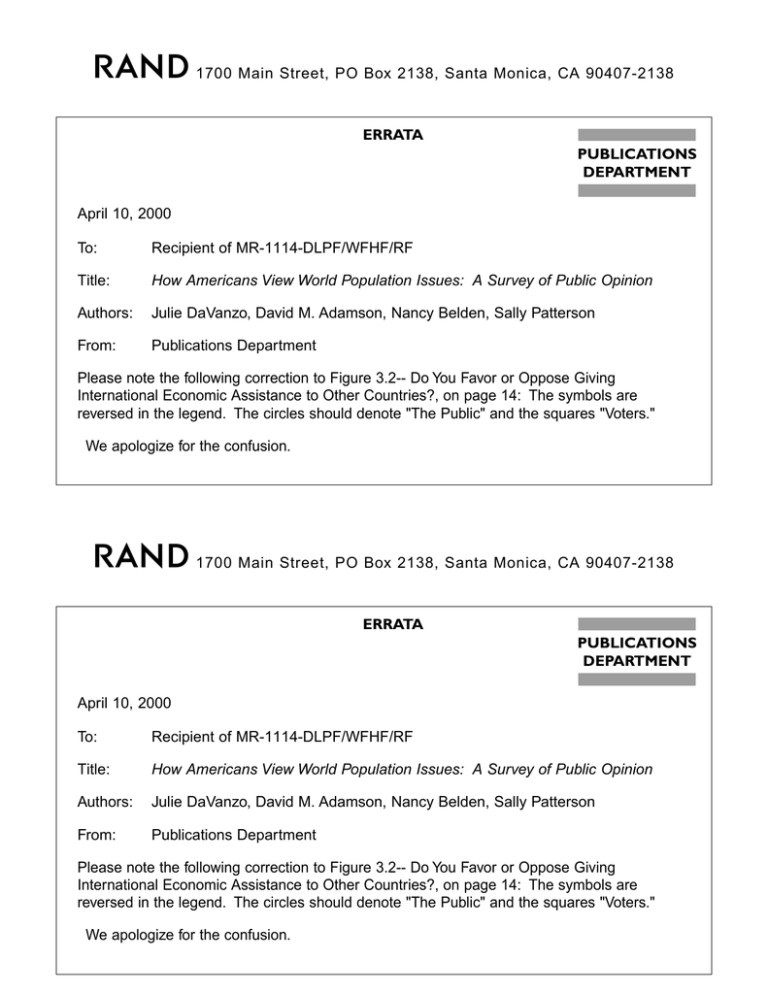
R 1700 Main Street, PO Box 2138, Santa Monica, CA 90407-2138 ERRATA PUBLICATIONS DEPARTMENT April 10, 2000 To: Recipient of MR-1114-DLPF/WFHF/RF Title: How Americans View World Population Issues: A Survey of Public Opinion Authors: Julie DaVanzo, David M. Adamson, Nancy Belden, Sally Patterson From: Publications Department Please note the following correction to Figure 3.2-- Do You Favor or Oppose Giving International Economic Assistance to Other Countries?, on page 14: The symbols are reversed in the legend. The circles should denote "The Public" and the squares "Voters." We apologize for the confusion. R 1700 Main Street, PO Box 2138, Santa Monica, CA 90407-2138 ERRATA PUBLICATIONS DEPARTMENT April 10, 2000 To: Recipient of MR-1114-DLPF/WFHF/RF Title: How Americans View World Population Issues: A Survey of Public Opinion Authors: Julie DaVanzo, David M. Adamson, Nancy Belden, Sally Patterson From: Publications Department Please note the following correction to Figure 3.2-- Do You Favor or Oppose Giving International Economic Assistance to Other Countries?, on page 14: The symbols are reversed in the legend. The circles should denote "The Public" and the squares "Voters." We apologize for the confusion. Chapter Three PUBLIC ATTITUDES TOWARD U.S. INTERNATIONAL ECONOMIC ASSISTANCE Our first set of survey questions sought to update information on public attitudes about U.S. international involvement, specifically with respect to international economic assistance and priorities for allocating it. Some policy analysts have suggested that America is moving into a neo-isolationist period, and previous public opinion research has shown that Americans’ concern for problems in the United States overshadows their sense of urgency about problems overseas. 1 This chapter looks at our findings regarding public support for various types of U.S. global economic assistance. AMERICAN SUPPORT FOR U.S. INTERNATIONAL ECONOMIC ASSISTANCE The current survey, taken during a period of economic prosperity in our own country, shows high levels of support for international economic assistance. Q15. Are you generally in favor or opposed to the U.S. giving economic assistance to other countries? Is that very much (in favor/opposed) or somewhat (in favor/opposed)? ______________ 1 For example, see Belden & Russonello, 1994; Doherty, 1993, p. 2267; Kull, 1995; Mur- avchik, 1996; and Yankelovich, 1991. 11 12 How Americans View World Population Issues Six in ten (59 percent) say they favor the United States giving economic assistance to other countries (see Figure 3.1). Although the percentage favoring economic assistance outweighs those opposing by 59 percent to 37 percent, most do not have strongly held views on the subject. Two-thirds of those favoring economic assistance say they support it only somewhat. As Table 3.1 illustrates, support for international economic assistance differs among various groups. Support is strongest among college graduates (73 percent favoring), African-Americans (69 percent), Democrats (67 percent), those with household incomes over $75,000 (65 percent), and liberals (64 percent). Nonetheless, support is 50 percent or greater for every subgroup shown in Table 3.1. A1681-3.1.0699 Don’t know/refused 4% Oppose very much 15% Favor very much 18% Oppose somewhat 22% Favor somewhat 41% Figure 3.1—Do You Favor or Oppose U.S. Economic Assistance to Other Countries? Attitudes Toward U.S. International Assistance 13 Table 3.1 Opinions Regarding Economic Assistance to Other Countries, by Socioeconomic and Demographic Characteristics % Oppose % Favor Strongly % Favor Somewhat 59 37 18 41 22 15 56 61 40 35 16 19 40 42 22 22 18 13 64 60 60 55 58 31 37 35 42 37 22 17 16 20 17 42 44 44 35 41 22 25 20 28 16 9 12 15 15 22 57 69 61 39 27 36 15 26 26 42 43 34 23 15 23 16 12 13 50 56 73 46 39 25 13 16 25 37 40 48 26 23 16 20 16 8 52 61 57 65 43 37 39 32 12 17 18 28 40 43 39 36 27 21 21 19 16 16 18 13 67 51 57 31 46 38 24 12 17 43 40 40 16 28 25 14 17 13 64 61 54 34 35 42 25 19 12 38 42 42 21 22 24 13 13 19 % Favor Total Gender Male Female Age 16–20 21–29 30–44 45–59 60+ Race/Ethnicity White African-American Hispanic Education High school grad or less Some college College+ Household Income <$25,000 $25,000–$49,999 $50,000–$74,999 >$75,000 Party Affiliation a Democrat Republican Independent Political Viewpoint Liberal Moderate Conservative % Oppose Somewhat % Oppose Strongly a Registered voters. It is important to keep in mind when considering the answers that show approval of international economic assistance and (as we will see later) high levels of support for the concept of family planning 14 How Americans View World Population Issues assistance that such support does not necessarily mean approval to spend at higher levels, or even at current levels. TRENDS IN SUPPORT FOR ECONOMIC ASSISTANCE Public-opinion surveys have been asking Americans about their support or opposition to U.S. economic assistance overseas since the early 1970s. The 59 percent level of support expressed in our 1998 survey is the highest since opinions on the subject were first tracked. The graph in Figure 3.2 tracks responses to the question of favoring or opposing economic assistance from a variety of surveys over the last 25 years. The low point measured in polling was in 1993, when less than half (43 percent) of the public said they favored U.S. economic assistance abroad. A1681-3.2.0699 100 The public Voters 90 Percentage in favor 80 70 59% 60 52% 50 40 47% 47% 54% 46% 50% 45% 43% 45% 30 20 10 0 1974 1978 1982 1986 1990 1994 1993 1998 NOTE: The 1974, 1978, 1982, 1990, and 1994 data come from the Chicago Council on Foreign Relations (1995). The 1986 data are from Belden (1986). The 1993 data are from Belden & Russonello (1993). The 1998 data are derived from the survey that is the basis for this report. All the studies used the terminology “economic aid” or “economic assistance to other countries or nations.” Figure 3.2—Do You Favor or Oppose Giving International Economic Assistance to Other Countries? Attitudes Toward U.S. International Assistance 15 VALUE OF INTERNATIONAL ECONOMIC ASSISTANCE TO THE UNITED STATES Q42. Do you agree or disagree: Money the United States spends helping people overseas eventually helps the U.S. economically? Is that strongly or somewhat? Sixty-one percent of the respondents agreed with this statement (see Figure 3.3). The factor analysis shows that approval of economic assistance (Q15) is associated with the belief that what we spend helping people overseas eventually helps the United States economically. When people believe we in the United States are getting something out of international economic aid, they are more likely to support that funding. A1681-3.3.0699 Don’t know/refused 4% Strongly disagree 18% Strongly agree 22% Somewhat disagree 16% Somewhat agree 39% Figure 3.3—Does Money the United States Spends Overseas Help the United States Economically? 16 How Americans View World Population Issues PRIORITIZING GOALS FOR INTERNATIONAL ECONOMIC ASSISTANCE We next inquired in the survey about a variety of types of possible goals for international economic assistance. The public approves of U.S. assistance being spent in a variety of ways. However, some goals are more strongly supported than others are. Q16–30. Thinking about where you would like to see the U.S. use its resources, here are some possible goals for U.S. government assistance programs to other countries. Using a scale where 1 means lowest priority and 10 means top priority, please rate these goals for U.S. government assistance overseas. Specifically, we asked the public to think about “where you would like to see the United States use its resources,” and to score 15 possible goals for U.S. government assistance to other countries, on a scale of “1” for lowest priority to “10” for top priority. In Figure 3.4 we plot the percentage saying “10” (highest priority) and show, on the right-hand side, the average values on the 1–10 scale. Two of the top goals address the well-being of children—the goals of improving children’s health and increasing child survival rates. Improving children’s health receives an average score of 7.8 out of a possible 10, with nearly four in ten giving it a “10” for top priority. Child survival has an average score of 7.4, with 33 percent giving this goal a score of 10. Protecting the environment and relieving human suffering were also high priorities. Environmental protection, at an average of 7.7, is one of the most popular aims of U.S. international economic assistance; it was scored a “10” by 36 percent of the public. Relieving suffering was scored a “10” by 30 percent, and has an average score of 7.4. Other goals that follow a little lower on the list include avoiding unintended pregnancy and efforts aimed at women’s well-being. Avoiding unintended pregnancy receives an average of 6.9 and a “10” from 30 percent. Addressing the needs of women also receives relatively strong levels of interest but at a lower rate than the child-focused goals. Improving women’s health receives an average score of 6.9 (with 25 percent ranking this goal a “10”) and improving the status of women obtains a 6.5 (with 19 percent saying “10”). Attitudes Toward U.S. International Assistance 17 A1681-3.4.0699 Percentage saying “10” as their priority Improving children’s health Mean 39% Protecting the global environment 36% Increasing survival rates of babies and young children 33% 7.8 7.7 7.4 Relieving human suffering brought about by civil war and natural disaster 30% 7.4 Helping women in poor countries avoid unintended pregnancies 30% 6.9 Promoting human rights 27% 7.0 Promoting democracy 25% 6.9 Improving women’s health 25% 6.9 Preventing civil wars and regional conflicts 22% 6.4 Helping countries slow their rate of population growth 22% 6.3 Promoting trade between the U.S. and other countries 20% 7.0 Supporting governments friendly to the U.S. 20% 6.8 Improving the status of women Improving men’s health Improving economic conditions in developing countries 19% 17% 15% 6.5 6.3 6.3 Figure 3.4—To Which of These Goals of U.S. Economic Assistance Would You Assign High Priority? Finally, the goal of addressing population growth receives a good score, but is lower priority than a number of others. Twenty-two percent rate slowing rates of population growth in other countries at 18 How Americans View World Population Issues “10,” and it obtains an average score of 6.3 (which, along with improving men’s health and improving economic conditions in developing countries, is the lowest average score in the figure). In sum, the data reveal that child-oriented goals for economic assistance overseas are among the most widely endorsed. Second, efforts aimed specifically at avoiding unintended pregnancy are popular, ranking much higher than those aimed at reducing population growth. Improving women’s health and the status of women are also highly rated. Finally, reducing population growth rates is accepted and endorsed by most—but ranks below most other possible ways for involvement that we queried. Three Types of Goals Factor analysis shows that the public clusters this group of fifteen goals into three sets. Within each set, people who rank one goal as high (or low) priority tend to rank the others similarly. The three sets are • health-oriented and other humanitarian goals, • international relations–oriented goals, and • helping countries slow their rate of population growth. Each of these is discussed below. Health-Oriented and Other Humanitarian Goals. The first group (or factor) includes the 10 goals that are primarily humanitarian and health-oriented. These include aiming to improve children’s, women’s, and men’s health, child survival rates, and women’s status and economic conditions; protect the environment; promote human rights; relieve the level of suffering; and reduce unintended pregnancy. People who give high scores to one of these goals are likely to support all the others in this set. In Appendix C, we show the order in which questions loaded onto this factor and we discuss the characteristics of the individuals who rank this factor (Factor 1A) highly. Individuals who are most enthusiastic about this type of goal are likely to be women, Democrats, African-Americans, and liberals. Attitudes Toward U.S. International Assistance 19 Figure 3.5 illustrates how differently various demographic groups score the highest-ranking goal of “improving children’s health.” African-Americans and Hispanics are especially likely to give priority to the goal of improving children’s health. Women and Democrats also rank this goal highly. Republicans are the least likely of all the groups shown in Figure 3.5 to rank this goal as a very high priority, although a quarter of Republicans rank this goal as a “10.” This is higher than the overall averages for many of the other goals we asked about (see Figure 3.4). We discuss support for specific health and humanitarian programs at the end of this chapter. A1681-3.5.0699 Percentage saying “10” as their priority for improving children’s health Total 39% 7.4 8.2 44% 16–20 21–29 30–44 45–59 60+ 7.9 7.8 7.9 7.9 7.7 42% 33% 40% 41% 37% 35% White African-American Hispanic Liberal Moderate Conservative 7.8 33% Male Female Democrat Republican Independent Mean 56% 53% 45% 7.7 8.6 8.2 41% 8.3 7.3 7.9 41% 40% 8.1 8.0 27% 34% Figure 3.5—What Percentage of Various Socioeconomic and Demographic Groups Assign High Priority to “Improving Children’s Health”? 7.5 20 How Americans View World Population Issues International Relations Goals. A second set of goals for assistance that grouped together in the factor analysis regards international relations: this includes promoting international trade, promoting democracy, supporting governments friendly to the United States, and preventing civil wars and conflicts. Figure 3.6 shows how different groups rate the goal of promoting trade. This is the goal that loaded first on the international relations factor in the factor analysis. Men, those age 45 or older, Hispanics, and African-Americans are most likely to rank the goal as a top priority, while women, younger people, and whites are the least likely to do so. Nonetheless, the mean figures of the 1–10-priority scores (shown on the right-hand side of Figure 3.6) exhibit remarkably little variation across subgroups. A1681-3.6.0699 Percentage saying “10” as their priority for promoting international trade 16–20 21–29 30–44 45–59 60+ White African-American Hispanic Democrat Republican Independent 7.0 20% Total Male Female Mean 7.1 24% 6.9 17% 7.0 6.8 7.0 7.1 7.0 16% 14% 19% 24% 23% 17% 29% 31% 22% 19% 18% 7.0 7.1 7.1 7.2 7.0 6.9 Figure 3.6—What Percentage of Various Socioeconomic and Demographic Groups Assign High Priority to “Promoting Trade”? Attitudes Toward U.S. International Assistance 21 The Goal of Slowing Population Growth. Finally, the third set has only one goal in it: helping countries slow their rates of population growth. The factor analysis helps demonstrate that a desire for addressing population growth stands apart from the other goals. That is, the priority respondents assigned to this goal is not statistically related to the priorities they assigned to the other 14 goals for international economic aid. Figure 3.7 shows the scores given to the goal of slowing the rate of population growth by different groups. A1681-3.7.0699 Percentage saying “10” as their priority for slowing population growth Total 6.0 19% 6.6 24% Female 21–29 6.3 22% Male 16–20 Mean 5.7 13% 6.1 19% 6.3 21% 30–44 6.3 23% 45–59 29% 6.8 60+ White 22% 6.4 African-American 22% 6.0 25% Hispanic 26% Democrat Republican 17% Independent Attend religious services more than once a week Attend religious services regularly (at least once a month) Attend religious services less 6.4 6.7 5.8 20% 6.3 17% 5.5 21% 24% 6.2 6.6 Figure 3.7—What Percentage of Various Socioeconomic and Demographic Groups Assign High Priority to Reducing Population Growth Rates? 22 How Americans View World Population Issues The people most concerned with population growth are Democrats, less frequent religious service attendees, older Americans, and women. The relationship with age is particularly strong. Respondents aged 60 or older are more than twice as likely to assign a priority of “10” to slowing the rate of population growth compared to those aged 16–20 (29 percent vs. 13 percent). VIEWS ON FUNDING PARTICULAR HEALTH AND HUMANITARIAN PROGRAMS As seen above, many of the most highly rated goals for U.S. government assistance to other countries pertain to health and humanitarian matters. We asked respondents whether they specifically favored or opposed U.S. aid programs contributing to funding of particular types of health and humanitarian programs in developing countries that are part of the Programme of Action recommended by 178 countries at the International Conference on Population and Development that was held in Cairo in 1994. Q32–39. Okay, now I’d like to ask your views about some kinds of possible U.S. aid programs to other countries. Please tell me if you favor or oppose the U.S. aid programs contributing to the funding of each of these in developing countries: 32. The U.S. sponsoring voluntary family planning programs in developing countries, 33. Programs to help women support themselves and their families financially, 34. Programs to give girls in developing countries the same opportunities for education as boys have, 35. Programs to improve women’s health generally, 36. Efforts to reduce domestic violence against women, 37. Programs to encourage men to take an active role in practicing family planning, 38. Programs to improve the rate of survival of babies and young children, Attitudes Toward U.S. International Assistance 23 39. Voluntary, safe abortions as part of reproductive health care in developing countries that request it? The results are shown in Table 3.2. Of the eight programs listed, support is very high and strong for all but voluntary safe abortion as Table 3.2 Support for Particular Health and Humanitarian Programs % Favor Programs to improve the rate of survival of babies and young children Programs to give girls in developing countries the same opportunities for education as boys have Programs to encourage men to take an active role in family planning Programs to improve women’s health generally Efforts to reduce domestic violence against women Programs to help women support themselves and their families financially The U.S. sponsoring voluntary family planning programs in developing countries Voluntary, safe abortion as part of reproductive health care in developing countries that request it % % Favor Oppose Strongly % Favor Somewhat % Oppose % Some- Oppose what Strongly 91 9 64 26 5 4 90 9 72 18 5 5 88 11 64 24 6 5 88 12 52 36 6 5 85 14 63 22 7 7 84 15 55 29 8 7 80 18 45 35 9 9 50 47 24 26 13 33 24 How Americans View World Population Issues part of reproductive health care in developing countries that request it. The factor analysis showed that people who supported one of the first seven programs listed tended to support the six others as well. We discuss the results for voluntary family planning programs and abortion in more detail in Chapter Five.
